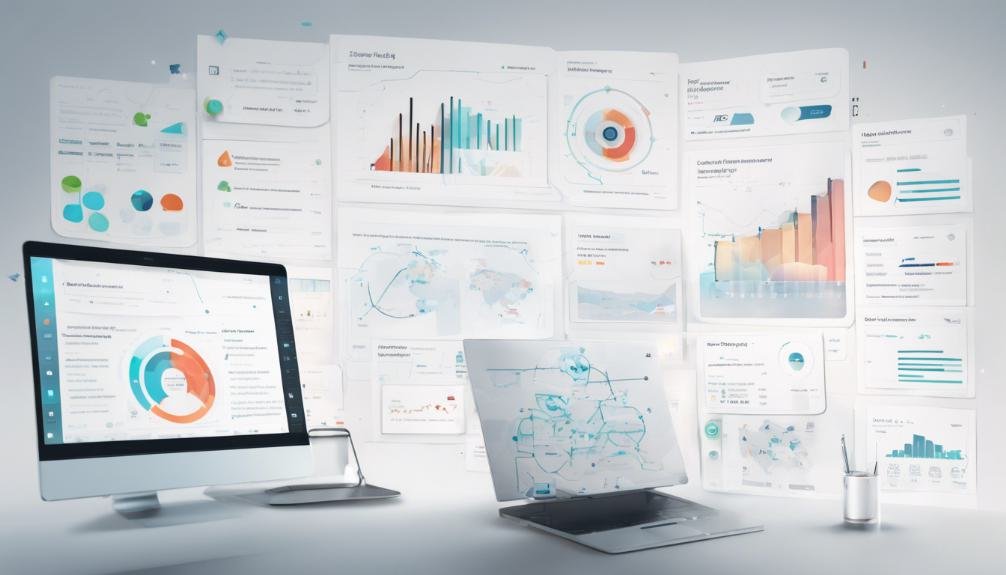AI for Regulatory Reporting
In the domain of regulatory reporting, the integration of AI technologies has revolutionized data management practices, offering unparalleled efficiency and precision. By harnessing the power of artificial intelligence, organizations can navigate the complex landscape of compliance requirements with agility and foresight. However, as AI continues to evolve and adapt to new challenges, the question arises: what implications does this have for the future of regulatory reporting processes?
Key Takeaways
- AI streamlines regulatory reporting processes by automating data collection and analysis.
- Automation technologies enhance compliance accuracy and efficiency.
- AI tools identify patterns and anomalies for improved risk management.
- Advanced AI tools offer proactive solutions for regulatory challenges.
- Regulatory AI trends focus on enhancing accuracy and efficiency through machine learning.
The Role of AI in Reporting
Artificial Intelligence (AI) plays an essential role in streamlining and enhancing the efficiency of regulatory reporting processes in various industries. Through advanced data analytics capabilities, AI can sift through vast amounts of data to identify patterns, anomalies, and trends that are important for regulatory compliance. By automating data collection, analysis, and interpretation, AI greatly reduces the time and resources needed for regulatory reporting tasks.
Furthermore, AI contributes to improved risk management by providing real-time insights into potential compliance risks. AI-powered systems can continuously monitor transactions, detect suspicious activities, and flag potential compliance issues promptly. This proactive approach enables organizations to address risks promptly, preventing regulatory breaches and financial penalties.
Automation Benefits for Compliance
With the implementation of automation technologies, organizations can realize substantial efficiency gains and enhanced accuracy in guaranteeing regulatory compliance. By automating compliance processes, companies can achieve notable cost savings through reduced manual labor requirements and decreased error rates. Automation streamlines repetitive tasks, such as data collection and report generation, allowing employees to focus on more strategic activities. This not only improves operational efficiency but also guarantees that regulatory requirements are met consistently and in a timely manner.
Furthermore, automation tools can enhance compliance monitoring by providing real-time insights into regulatory changes and their impact on the organization. By staying updated on evolving regulations, companies can proactively adjust their processes to remain compliant, reducing the risk of non-compliance penalties. The use of automation also facilitates seamless audit trails, making it easier to track and report on compliance activities when required.
Enhanced Accuracy With AI
Utilizing advanced AI technologies can greatly enhance the accuracy of regulatory reporting processes in organizations. By incorporating data validation and predictive analytics, AI can guarantee that the information submitted for regulatory purposes is error-free and reliable. Compliance monitoring becomes more efficient through AI's ability to continuously assess datasets for any discrepancies or deviations from regulatory requirements. Additionally, AI's predictive analytics can anticipate potential risks in regulatory reporting, allowing organizations to proactively address issues before they escalate.
| Enhanced Accuracy with AI | Benefits |
|---|---|
| Data Validation | Guarantees error-free reporting |
| Predictive Analytics | Anticipates potential risks |
| Compliance Monitoring | Continuous assessment |
| Risk Assessment | Proactive issue resolution |
Incorporating AI into regulatory reporting processes not only enhances accuracy but also streamlines compliance efforts. With AI-powered tools, organizations can navigate regulatory requirements with greater precision and confidence.
AI Tools for Regulatory Challenges
Employing advanced AI tools can revolutionize how organizations tackle regulatory challenges, offering sophisticated solutions for complex compliance requirements. Data analytics play an essential role in regulatory reporting, enabling firms to sift through vast amounts of data to guarantee accurate and timely submissions.
AI-powered data analytics tools can quickly identify patterns, anomalies, and trends within regulatory data, enhancing the efficiency and effectiveness of compliance processes.
Furthermore, AI tools can greatly enhance risk management practices within organizations. By leveraging machine learning algorithms, these tools can analyze historical data to predict potential risks, enabling proactive risk mitigation strategies. This predictive capability allows firms to stay ahead of regulatory changes and evolving compliance requirements, reducing the likelihood of non-compliance issues.
Future Trends in Regulatory AI
The domain of regulatory AI is evolving rapidly, with emerging trends shaping the future of compliance and risk management practices.
In the sphere of AI applications for regulatory reporting, future trends indicate a significant shift towards more advanced technologies. These advancements are expected to enhance the efficiency and accuracy of regulatory processes, enabling financial institutions to meet evolving compliance requirements effectively.
One key trend in regulatory AI is the integration of machine learning algorithms to improve data analysis and decision-making capabilities. By leveraging AI-driven insights, organizations can proactively identify potential risks and compliance issues, enabling them to take preemptive actions to mitigate these challenges.
Moreover, regulatory advancements in natural language processing (NLP) are revolutionizing the way regulatory documents are analyzed and interpreted. NLP-powered AI applications can extract valuable insights from unstructured data sources, such as regulatory texts and compliance reports, streamlining the regulatory reporting process and enhancing overall compliance efforts.
Conclusion
To sum up, the integration of AI in regulatory reporting offers significant advantages in streamlining processes, enhancing accuracy, and improving risk management.
With automation technologies reducing manual labor and error rates, organizations can guarantee error-free reporting and proactive compliance monitoring.
As AI continues to evolve, what new possibilities and challenges will emerge in the field of regulatory reporting?







